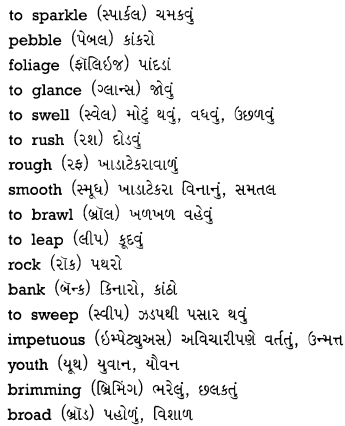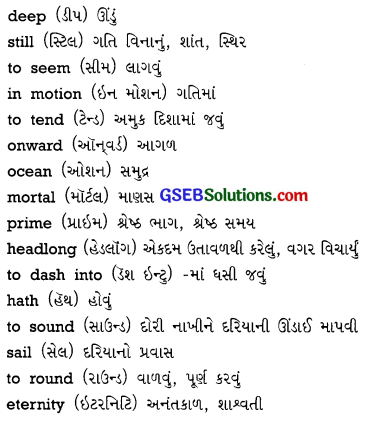Gujarat Board GSEB Solutions Class 9 English Second Language Poem 1 The River Textbook Exercise Questions and Answers.
GSEB Class 9 English Textbook Solutions Poem 1 The River (Second Language)
GSEB Class 9 English The River Text Book Questions and Answers
Comprehension
1. Give the opposites.
(1) louder X softer
(2) faster X slower
(3) broad X narrow
(4) deep X shallow
(5) wider X narrower
![]()
2. Add a rhyming word.
(1) dancing, glancing, prancing
(2) leaping, sweeping, reaping
(3) motion, ocean, commotion
(4) arrow, narrow, borrow
(5) time, prime, lime
3. Answer the questions.
Question 1.
What is the destination of the river?
Answer:
The ocean is the destination of the river.
Question 2.
Why does the poet compare the river with a child in the first stanza?
Answer:
The poet feels that like a playful child, the river sparkles bright as it flows, dances over the pebbles and glances through flowers and foliage.
Question 3.
Describe the movement of the river.
Answer:
The river swells and rushes on louder and faster. It is brawling and leaping over the rocks. It is sweeping by the rose-banks like careless youth.
![]()
Question 4.
Why does the poet compare the sea with eternity?
Answer:
The sea can never be measured. It is endless. So the poet compares it with eternity
Question 5.
What does the word ‘still’ mean In
‘Seeming still – yet still in motion’?
Answer:
In ‘Seeming still – yet still in motion’, the word ‘still’ has two meanings:
(1) In ‘seeming still’, it means motionless.
(2) In ‘yet still in motion’ means even now
Read the following stanzas and answer the questions.
(1) River, river, little river
Bright you sparkle on your way;
O’er the yellow pebbles dancing,
Through the flowers and foliage glancing,
Like a child at play.
Question 1.
What does the river do over the pebbles
Answer:
The river goes dancing over the pebbles.
Question 2.
Through what does the river glance?
Answer:
The river glances through the flowers and foliage.
![]()
Question 3.
To whom is the river compared?
Answer:
The river is compared to a playful child.
Question 4.
Write the rhyming words in the stanza.
Answer:
way-play, dancing-glancing
(2) River, river, swelling river!
On you rush through rough and smooth;
Louder, faster, brawling, leaping,
Over rocks, by rose-banks sweeping
Like impetuous youth.
Question 1.
What does ‘swelling river’ mean?
Answer:
‘Swelling river’ means a growing river.
Question 2.
How does the river flow over the rocks ?
Answer:
The river flows louder, faster, brawling and leaping over the rocks.
Question 3.
How does the river flow by the rose- banks ?
Answer:
The river is sweeping by the rose-banks.
![]()
Question 4.
To whom is the river compared?
Answer:
The river is compared to a careless youth.
Question 5.
Write the rhyming words in the stanza.
Answer:
smooth-youth, leaping-sweeping
(3) River, river, brimming river !
Broad and deep, and still as time;
Seeming still, yet still in motion,
Tending onward to the ocean,
Just like mortal prime.
Question 1.
What does ‘brimming river mean?
Answer:
‘Brimming river’ means an overflowing river.
Question 2.
Towards what is the river flowing?
Answer:
The river is flowing towards the ocean.
Question 3.
To whom is the river compared?
Answer:
The river is compared to a middle-aged man
![]()
Question 4.
Write the rhyming words in the stanza.
Answer:
time-prime, motion-ocean
Question 5.
Explain ‘Seeming still, yet in motion.
Answer:
‘Seeming still, yet in motion’ means the river appears to be motionless, but still it is flowing quietly.
(4) River, river, headlong river !
Down you dash into the sea,
Sea that line hath never sounded,
Sea that sail hath never rounded,
Like Eternity.
Question 1.
Where does the river dash into?
Answer:
The river dashes into the sea.
Question 2.
To what is the sea compared?
Answer:
The sea is compared to Eternity.
Question 3.
Why does the poet compare the sea to Eternity?
Answer:
The poet compares the sea to Eternity because the depth of the sea can never be measured and it keeps on flowing endlessly.
![]()
Question 4.
Write the rhyming words in the stanza.
Answer:
rounded-sounded
The River Summary in Gujarati
નદી, નદી, નાનકડી નદી !
આનંદથી ચમકતી તારા માર્ગમાં;
પીળા કાંકરા પર નાચતી-કૂદતી,
ફૂલો અને પાંદડાઓમાંથી જોતી-જોતી,
જાણે કે એક રમતું બાળક.
નદી, નદી, ઊછળતી નદી !
ખાડાટેકરાવાળા અને સમતલ રસ્તે તું દોડતી જાય છે;
વધુ મોટા અવાજ સાથે, ઝડપથી, ખળખળ વહેતી,
કૂદતી, પથરા ઉપરથી, કાંઠા પર ગુલાબ(ના છોડ)ની હારને સ્પર્શતી
ઝડપથી દોડી જતી.
જાણે કે ઉન્મત્ત યૌવન.
![]()
નદી, નદી, છલકતી નદી !
વિશાળ અને ઊંડી, અને સમયની જેમ સ્થિર;
સ્થિર લાગે, તોપણ ગતિમાં (વહેતી),
સમુદ્રની દિશામાં આગળ વહેતી,
જાણે કે જીવનના શ્રેષ્ઠ સમયમાં માણસ.
નદી, નદી, ઉતાવળી નદી !
દરિયામાં તું ધસી જતી,
દરિયો – જેની ઊંડાઈ અમાપ છે,
દરિયો – જેનો પ્રવાસ નિરંતર છે,
જાણે કે અનંતકાળ.
Word Meanings

